POSTER Tauopathy & Model Exploration
Characterization of a Transgenic Mouse Model of Tauopathy Using Quantitative EEG: Does Tau Pathology Lead to Disrupted EEG Spectra?
Home » Resources / Publications & Posters / Poster: Characterization of a Transgenic Mouse Model of Tauopathy Using Quantitative EEG
Alzheimer’s disease (AD), the most common form of dementia, is associated with two pathological hallmarks: parenchymal beta amyloid deposition and intraneuronal neurofibrillary tangles formed from hyperphosphorylated tau. However, lack of understanding of how these primary pathologies result in cognitive deficits remains a hurdle to the development of meaningful therapeutics.
To investigate a translatable model related to tau pathology, we studied changes in EEG characteristics with age in the P301L tauopathy mouse model. P301L mice overexpress the 4R/2N isoform of human tau under control of the mouse prion promoter on a C57BL/6 background. We correlated EEG signatures to the development of tau pathology measured by histopathological methods. Given that neuroinflammation is implicated as the effector of synaptic dysfunction induced by primary amyloid and tau pathology in AD, we also investigated whether expression of P301L tau was associated with neuroinflammatory changes.

FILL OUT THE FORM TO DOWNLOAD THE POSTER
Related posts:
- Poster: EEG Phenotyping as a Loop Translation Tool to Address the Pathophysiology of GABA-A Signaling-associated Brain Disorders
- Poster: Standardized Pharmaco-Sleep-Electroencephalography as a Preclinical Tool for Antidepressant Drug Profiling
- Publication: Differential Effects of Antiepileptic Drugs on Focal Seizures in the Intrahippocampal Kainate Mouse Model of Mesial Temporal Lobe Epilepsy
- Poster: The Use of Quantitative EEG and Phase Amplitude Coupling for the Identification of New Brain Functional Signatures
- Poster: The SynapCell MTLE Model, a Predictive Model of Focal Epilepsy for Drug Discovery
- Poster: Pharmacological Assessment of Anti-Seizure Medications in the Rat Amygdala-Kindling Model
